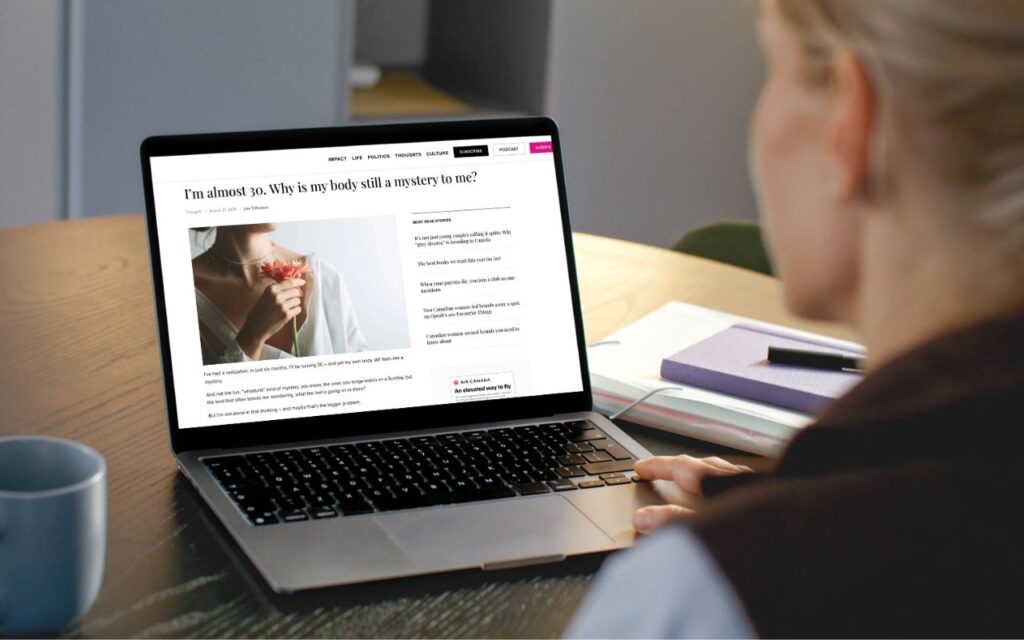
When was the last time you practiced purposeful empathy?
It may not be a phrase that immediately springs to mind, but for Anita Nowak, it’s top of mind both personally and professionally.
Nowak first began researching empathy during her PhD studies in the Faculty of Education at McGill University. Her goal was to design curricula that would inspire the next generation of changemakers to seek careers as social impact leaders.
But as she dove deeper into the research, she realized that empathy is our superpower.
“I fell in love with empathy as a skill that we’re born with, and that we can develop over time, to create positive change in the world, in our relationships, our organizations, and our lives,” she said.
We were curious to learn more, so we sat down with Nowak for a chat about her latest book, Purposeful Empathy: Tapping Our Hidden Superpower for Personal, Organizational, and Social Change. Below, we’ve compiled some of her helpful tips for practicing more empathy on purpose at work and in our daily lives.
THT: What is empathy, and how is it different from, say, pity or other feelings we have?
Nowak: I like to put it on a continuum, from left to right, beginning with pity, followed by sympathy, compassion, and finally empathy. These words are often treated as synonyms, but they really don’t mean the same thing. On the pity side, there’s power asymmetry embedded in relationships. Meaning, if you pity someone, you look down on them with disdain. But with empathy, that asymmetry disappears.
I define empathy as the innate trait that unites us in our common humanity. Empathy is the connective tissue that allows us to relate to one another because we all share feelings like love, fear, shame, hope, etc. That said, we have to be careful not to project our feelings onto someone else or assume that we know what someone else is going through.
THT: Your new book emphasizes purposeful empathy. What does that look like in practice?
Nowak: Let me answer that question with a story.
About a dozen years ago, I was standing in a long lineup during the holiday season at an overseas courier service in downtown Montreal. It took half an hour to get to the counter, and when the customer service agent greeted me, she was remarkably rude. I remember being caught off guard, and my first reaction was, “How dare she speak to me like that?”
But it was around that time that I was learning about the neuroscience of empathy, and that we can become more empathic with practice, so I made the split-second decision to extend empathy. I looked at her and asked, “Are you okay?” She looked back for a second, trying to decipher if I was being sincere, and then burst into tears. Between sobs, she said, “I’ve been working double shifts for two weeks straight. My son is at home with a fever, and I think I’m getting sick. It’s 3 p.m. and I haven’t had a lunch break. I’m just flat-out exhausted.” My heart softened because I could feel her pain, and we held hands across the counter.
I share this story for a few reasons: First, because I’m sure we can all relate to both sides of that equation. Second, because that’s when I understood at a visceral level that we can decide in an instant to practice empathy on purpose — and doing so can change everything.
I also want to circle back to the neuroscience of empathy. If my brain had been connected to an fMRI machine at the time we were holding hands — locked in what I call an empathic embrace — the scan would have revealed that the pleasure and reward centres of my brain were lit up, just like they do when we eat something delicious, are high on psychedelics, or are enjoying the bliss of an orgasm. When we feel emotionally connected to someone, it feels good to our brains!
Plus, it’s also good for our bodies. Again, at that moment, machines monitoring my vitals would have been able to detect deeper breathing. Any stress hormones like cortisol flowing through my body would have been replaced by some “feel-good” hormones like serotonin and oxytocin. What’s exciting about purposeful empathy is that it benefits the giver as much as the receiver.
THT: That’s a great example of empathy in our everyday lives. What about at work?
Nowak: Great question, because we desperately need more empathic leadership in the workplace! Here’s the deal: it’s a neurological fact that our brains cannot extend empathy when we’re feeling stressed, anxious, or overwhelmed, but at work, don’t we all feel that way, at least some of the time?
So here’s a six-step process toward empathic leadership using a workplace example. Let’s say Susan has just come out of a terrible meeting where she was raked over the coals because a project she’s leading has gone off the rails and she’s feeling a sense of shame. She goes back to her office berating herself the whole time, and a minute later there’s a knock on her door. A direct report asks, “Susan, do you have a minute?” To which Susan replies (knowing this will be a sensitive conversation), “Of course, come in.”
How can Susan extend empathy to her employee when she’s feeling emotionally triggered herself? And what if the employee tells her she needs time off to tend to an ailing parent — precisely when her team has a major client deadline and it’s an all-hands-on deck moment?
Here are the six steps:
Step 1: Self-awareness
Because we spend so much of our lives in our heads, listening to our thoughts, we don’t have much experience listening to our bodies — but they are constantly communicating how we’re feeling. That’s why self-awareness is so important. To become an empathic leader (or parent or citizen), the first step is to learn to pay attention to the signals in our bodies that are telling us we feel stressed or emotionally triggered.
Step 2: Self-regulation
Once we’re conscious of any negative feelings, then it’s possible to practice self-regulation — a psychological term that refers to managing our emotions.
So, how do we turn down the volume of stress we’re feeling? One of the simplest, most-effective ways is known as box breathing — inhaling for five seconds, holding for five seconds, exhaling for five seconds, and holding for a final five seconds before repeating the process three or four times. Once our body and brain are feeling less stress, it then becomes possible to access our empathic proclivities.
Step 3: Bridge-crossing
This step is quick and simple. Remember when I asked that woman: “Are you okay?” That was bridge-crossing. It was no longer about me, and all about her.
Step 4: Perspective-taking
This step is about holding space for someone else and extending empathy on purpose, and involves two important strategies. First, to privilege silence. In our culture, we tend to be allergic to silence and are quick to offer advice or say, “I know what you mean.”
But to somebody sharing something emotionally significant, silence is golden. Sometimes, it’s even an invitation to share more. Second, to reflect back a few words that were just spoken — just as therapists are trained to do. Initially, this may feel robotic, but when someone hears words they’ve just spoken, it feels like a balm. Like they’ve really been heard.
Step 5: Empathic action
After Susan hears about her employee’s personal situation, and the need to take a few days off, is that the moment to re-organize a project plan to make the client deadline? No — unless you want to miss a major opportunity for empathic leadership! Now is the time for empathic action.
I recommend that Susan say something along these lines: “Thank you for sharing what’s going on with you. And I’m sorry this is happening. I hope you take good care of yourself right now. Maybe it would be a good idea to call a friend or go for a walk. Then, when you’re ready, let’s discuss how we can modify our work plan.” You have no idea how different that employee will feel. Appreciation and engagement will go through the roof.
Step 6: Self-empathy
Finally, Susan needs to practice self-empathy. Under normal circumstances, she would go back to her inbox — even though she’s still carrying the baggage of the meeting gone wrong, followed by a heavy conversation with her direct report. The mistake so many of us make is to hunker down and plow through things. But we have to learn to be kinder to ourselves!
Otherwise, we can easily tip into empathy fatigue and be heading toward burnout. That’s why self-empathy is key to purposeful empathy. As the old adage goes: On an airplane, we have to put the oxygen mask on ourselves first.
THT: How can we use empathy as a strength in the workplace, especially in leadership positions?
Nowak: When I give corporate talks, I’m often told that empathy sounds great in theory, but would hinder performance. Nothing could be further from the truth. Empathic workplaces have higher levels of trust, better communication, and the capacity to innovate — precisely because there are high levels of social capital.
Studies show that the lion’s share of CEOs understand that empathy matters to their bottom line. But seven out of ten leaders fear showing empathy in the workplace because they’d be less respected. That’s a leadership myth worth busting.






